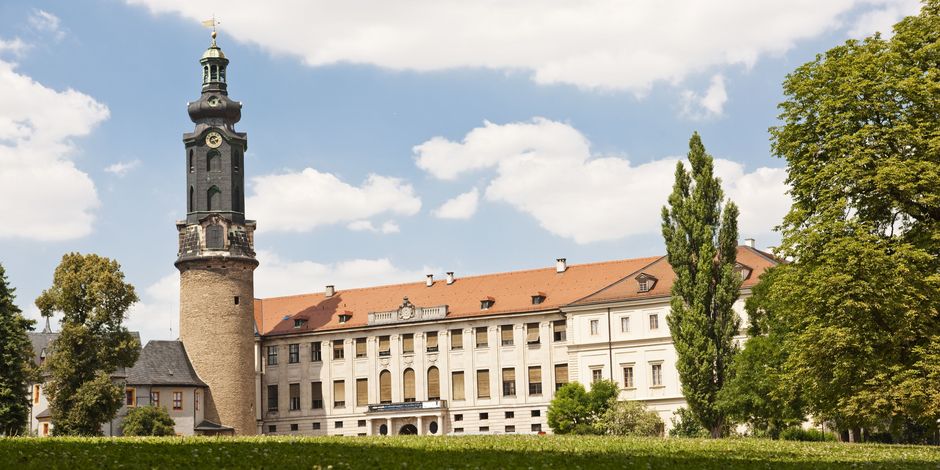Projects of the Klassik Stiftung Weimar are funded by the European Regional Development Fund (ERDF) and the Free State of Thuringia, represented by the State Chancellery of Thuringia, Department of Culture and the Arts.

History of the Klassik Stiftung Weimar
The Klassik Stiftung Weimar was established on 1 January 2003 when the Stiftung Weimarer Klassik merged with the Weimar Art Collections. This fusion placed extensive art holdings formerly owned by the Grand Ducal House of Saxony-Weimar-Eisenach under the curatorship of the Klassik Stiftung Weimar. Since then, the artistic, literary and scientific achievements and masterpieces of the Weimar Classical period – shaped in large part by Johann Wolfgang von Goethe – have been reunited with the art collection of Weimar’s ducal and grand ducal houses which date back almost five hundred years. The tradition of art patronage so strongly cultivated by this important central German dynasty continued in 2003 when significant estates of the Goethe- und Schiller-Archiv, the ducal art collections and valuable library collections were permanently safeguarded for the public domain thanks to an amicable settlement between Princess Leonie of Saxony-Weimar-Eisenach and the Free State of Thuringia.
With over 20 museums, five castles and historical park grounds, the residences of numerous artists and intellectuals, the Herzogin Anna Amalia Bibliothek and the Goethe- und Schiller-Archiv, the Klassik Stiftung Weimar represents an extraordinarily dense ensemble of German cultural heritage spanning the 16th to the 20th century. The history and constitution of Germany’s second largest cultural foundation are closely intertwined with the most important chapters of Germany history of the 20th century.
The beginnings of the foundation date back to the late 19th century. Following the death of Goethe’s grandson Wolfgang Walther von Goethe in 1885, the Grand Duchy of Saxony-Weimar-Eisenach was named as legatee to the poet’s library and extensive collections stored at his residence on Frauenplan. Goethe’s valuable written estate was bequeathed to Grand Duchess Sophie personally. That same year, Sophie and Wilhelm Ernst von Saxony-Weimar-Eisenach founded the Goethe National Museum and the Goethe Archive. The latter was renamed the “Goethe- und Schiller-Archiv” in 1889 with the addition of the Schiller estate.
Following the November Revolution of 1918, which culminated in the abdication of Wilhelm Ernst and the founding of the Weimar Republic, the former Grand Ducal House and the state of Thuringia formally agreed to establish the Weimar State Art Collections in 1922. The Goethe- und Schiller-Archiv remained the property of the Hereditary Grand Duke Karl-August who managed the archive together with the state of Thuringia and the Goethe Society until 1947. The Grand Ducal Library was renamed the Thuringian State Library.
At the end of the Nazi dictatorship and World War II, Weimar and its collections were in a desolate condition. The East German government established the National Research and Memorial Sites of Classic German Literature in Weimar (NFG) in 1953. This umbrella organisation assumed responsibility for the cultural assets which had been owned by the grand ducal family and were nationalised in 1921, and Karl-August’s privately-owned collections, which the East German regime expropriated in 1948. The historical sites included the summer residences and parks, the Nietzsche-Archiv and the Thuringian State Library. After German reunification, these NFG-managed sites and their collections were placed under the aegis of a newly established organisation in October 1991 which became an independent foundation in 1994, the Stiftung Weimarer Klassik.
The Weimar Art Collections, which oversaw the maintenance and reorganisation of the ducal artworks in the State Museum, Belvedere Castle and the Weimar City Castle, were placed under the management of the city of Weimar in 1965. Due to wartime destruction of the State Museum (formerly the Grand Ducal Museum and today the Museum Neues Weimar), all of the collections were stored at the Weimar City Castle. After 1990 the Weimar Art Collections were restructured into distinct holdings dedicated to modernism, the Bauhaus and contemporary art and were then merged into the newly established Klassik Stiftung Weimar in 2003.

